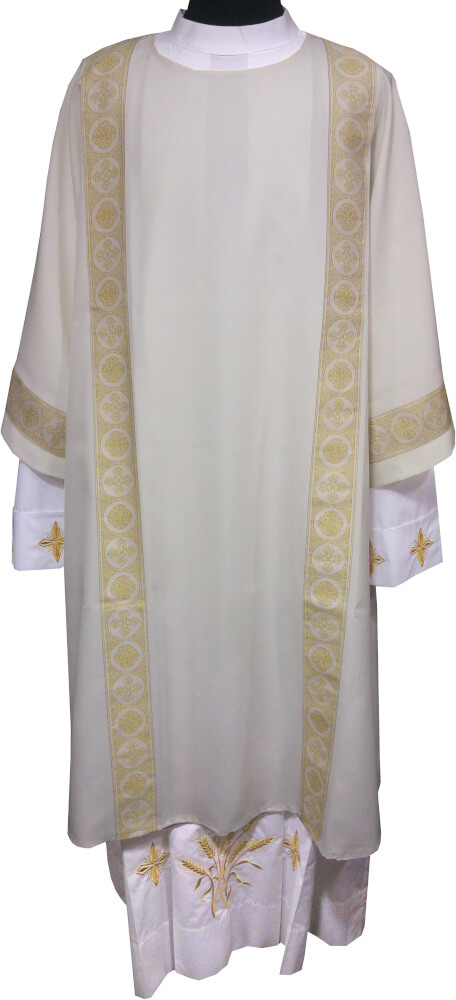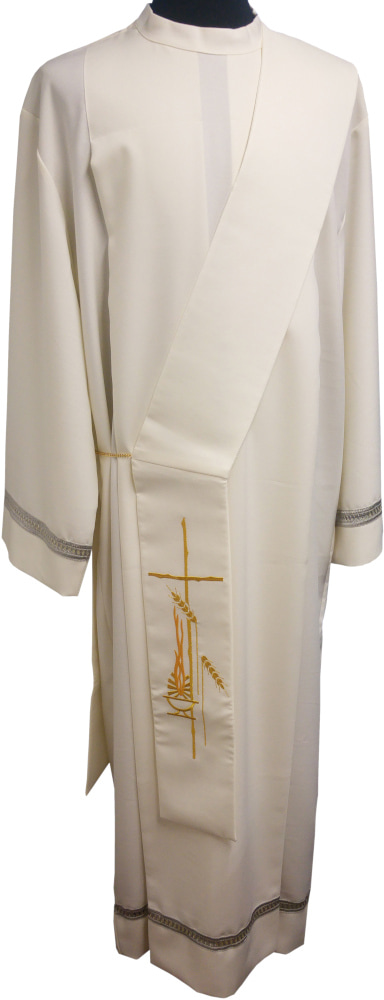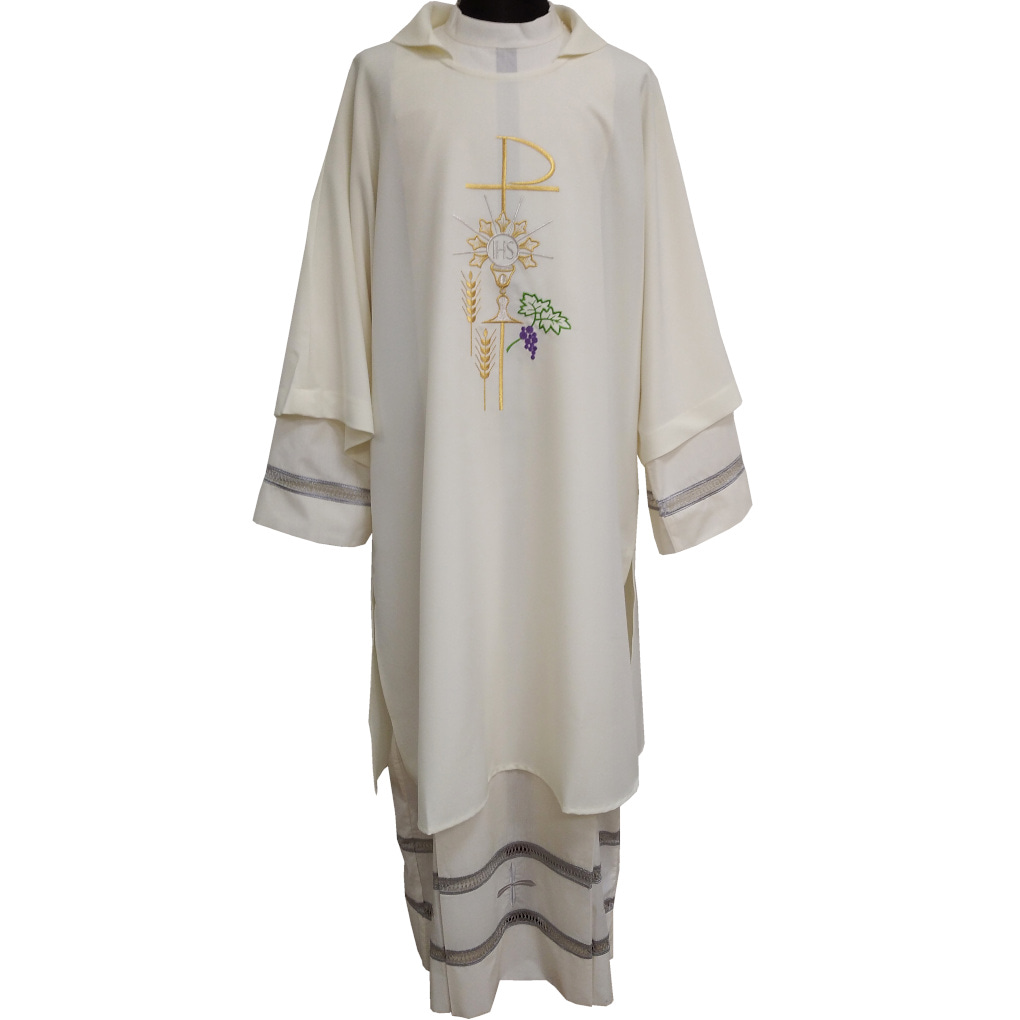
Catholic Church Deacon
The deacon in the Catholic Church serves the community, performs celebrations, and contributes to spiritual growth. To be a permanent deacon in Spain, one must be a man between 35 to 65 years old with theological training. The ordination is a sacramental act performed by the Bishop with symbolic gestures. Deacons can be transitional or permanent, wearing distinctive vestments of a stole and dalmatic. During the ordination, gifts such as a stole, dalmatic, and the Book of the Gospels are appropriate.
- 1. Deacons in the Catholic Church
- 2. What is the function of a deacon
- 3. How to become a permanent deacon? Requirements to be a permanent deacon in Spain
- 4. The ordination of Christian deacons
- 5. Transitional and permanent deacons
- 6. Vestment of the Catholic Christian deacon
- 7. What can be given to a deacon at his ordination?
Deacons in the Catholic Church
 Christian deacons play a significant role in today's Catholic Church. The functions a person performs after receiving ordination in the diaconal order are contained in the very word by which they are named: Catholic deacons.
Christian deacons play a significant role in today's Catholic Church. The functions a person performs after receiving ordination in the diaconal order are contained in the very word by which they are named: Catholic deacons.
The term deacon etymologically comes from the Greek word "διακονία", "diakonia", meaning service. That is, once ordained, the deacon's primary task is to serve the Catholic Church, specifically serving the other two degrees of the sacrament of holy orders: the episcopal order (the Bishops) and the order of the presbyterate (the priests or presbyters).
In this service, the activities that Catholic deacons can assume are very diverse, ranging from administrative and organizational work at the parish level to meeting purely ecclesial needs. Christian deacons, being consecrated upon receiving the Sacrament of Holy Orders, can carry out various celebrations within the Catholic liturgy that lay people cannot perform. Some of the tasks that are part of the Diaconate include celebrating baptisms, distributing communion, officiating Catholic weddings, proclaiming and reading the Bible and the Gospel, attending to the sick with viaticum, presiding over wakes and funerals, etc...
Although there are many attributions of deacons after being ordained by the Bishop, there are a series of functions that the Catholic Church reserves for priests. Within the exclusive attributions for the episcopal order and the order of the presbyterate are imparting the sacrament of the Eucharist (celebrating mass), confessing the faithful, administering the anointing of the sick, ...
What is the function of a deacon
The role of the deacon in the Catholic Church is of great importance. Their function goes beyond being a help to the parish priest or priest, as they perform a vital service to the people of God.
Deacons contribute to the spiritual growth of the community and to serving those in need, carrying out a large number of activities such as:
-
Administering the Sacrament of Baptism
Deacons have the faculty to solemnly administer the sacrament of baptism.
-
Performing tasks related to the Eucharist
Furthermore, they can preserve and distribute the Eucharist, being ministers of the exposition of the Blessed Sacrament and of the eucharistic blessing.
They also have the authority and faculty to distribute the Eucharist regularly and habitually.
Even being able to bring the viaticum to the dying.
-
Assisting and blessing marriage
On behalf of the Church, deacons have the responsibility to assist and bless marriage. Their presence in this sacred celebration is of great importance, as they represent the service and blessing of the Church in this sacrament.
-
Instructing and exhorting the faithful
Deacons have the task of reading the Holy Scripture to the faithful, instructing contributes to spiritual growth. To be a permanent deacon in Spain, one must be a man aged 35 to 65 with theological training. The ordination is a sacramental act performed by the Bishop with symbolic gestures. Deacons can be transitional or permanent, wearing characteristic vestments of the stole and dalmatic. At ordination, gifts such as a stole, dalmatic, and Book of the Gospels are appropriate.
-
Presiding over the worship and prayer of the faithful
Deacons have the privilege of presiding over the worship and prayer of the faithful. This involves leading liturgical prayers and actively participating in the celebration of the Eucharist.
How to be a permanent deacon? Requirements to be a permanent deacon in Spain
The diaconate is an ordained ministry within the Catholic church. A service within the Catholic Church established and authorized through sacramental ordination, through a sacred rite in which a person is consecrated, receiving the to serve as a deacon.
The Spanish Episcopal Conference has established a series of requirements for a person to be sacramentally ordained to serve as a permanent deacon. Some of the most important are:
-
Deacons have to be men
The permanent diaconate is an ordained sacrament, so it is reserved exclusively for men.
-
Age
As a general term, the limits of 35 and 65 years of age at the time of ordination are established to be ordained as a deacon.
-
Civil status of deacons
The established requirements allow that no person can be excluded from the diaconate due to their civil status. Both single and married men can be ordained as deacons.
Those who wish to be ordained and are married must meet an additional requirement, they must have the consent of their wife to continue on the path of diaconate.
-
Diaconal training
It is essential to receive the necessary training to carry out the diaconal functions with guarantees. It is necessary to complete a process of theological and pastoral training, which includes studies in areas such as Sacred Scripture, dogmatic and moral theology, liturgy, and pastoral care.
The ordination of Christian deacons
The ordination of Catholic deacons, Ordinatio, is a sacramental act carried out by the Bishop.
The diaconal ordination is the moment that marks the beginning of the path of service and commitment to God and the community of a deacon.
After years of theological, pastoral, and spiritual preparation supervised by the competent ecclesiastical authority, the deacons are prepared to receive their sacramental ordination.
During the diaconal ordination, the bishop performs a series of rites and gestures that symbolize the transmission of the sacrament of order to the candidate for the diaconate.
The bishop lays hands on the candidate for the diaconate. This gesture is a symbol of the transmission of power and grace of the Holy Spirit for the diaconal ministry.
Along with the laying on of hands, the bishop prays a specific ordination prayer for the diaconate. This prayer invokes the grace of God and asks that the candidate be strengthened and empowered to fulfill their diaconal function.
In addition to the laying on of hands, the Bishop delivers various religious objects with high symbolic value.
On the one hand, the bishop gives the deacon the stole and the dalmatic. Religious ornaments typical of the diaconate. These objects symbolize the ministry and authority that the deacon will receive to serve the Church.
On the other hand, the bishop delivers the book of the Gospels. This gesture represents the important charge that the deacon has to proclaim the Word of God and preach the Gospel in the liturgy and other liturgical celebrations.
Transitional and permanent deacons
The diaconal order is made up of men who are classified into two groups based on the objectives set within the Catholic Church.
-
Transitional deacons
The transitional deacons are a type of deacons whose goal is to reach the order of the priesthood, that is, to become priests. The transitional diaconate is a learning epoch in which future presbyters prepare for priestly ordination.
Transitional deacons during their ordination make the Promise of Celibacy, Profession of Faith, and Oath of Fidelity.
-
Permanent deacons
The permanent deacons are the second group within the diaconal order. Permanent deacons are all those men who do not have immediate ordination to the priesthood as their goal.
Any man committed to the community and the Holy Catholic Church, merciful and respectful can be a candidate to be ordained as a deacon once he has completed his studies.
The rules do not limit diaconal ordination to single people. Married men can also aspire to belong to the diaconal order. If the permanent deacon were to become widowed, he could not remarry. He could aspire to be ordained as a priest.
Attire of the Catholic Christian deacon
The Holy Catholic Church is full of symbolic elements that remind believers of the word of Jesus. Within all the liturgical vestments used during Christian celebrations, there are two that are related to the diaconal order. These religious garments are the diaconal stole, or stole for deacons, and the dalmatic.
 The liturgical ornaments that deacons wear during celebrations must be the same color as the vestments worn by the priest.
The liturgical ornaments that deacons wear during celebrations must be the same color as the vestments worn by the priest.
The diaconal stole
The stole is a liturgical ornament used by presbyters, deacons, and bishops. The diaconal stole has its own characteristics that differentiate it from the stoles worn by those ordained as priests or bishops.
These intrinsic characteristics are determined by the way in which deacons wear the stole. Members of the diaconal order, unlike presbyters and bishops, wear the stole over the left shoulder exclusively. The right shoulder is left free as a symbol of their commitment to serving others. That is, Catholic priests and bishops wear the stole around the neck, while deacons wear the diaconal stole over the left shoulder crossed over the chest to the right side of the hip.
The diaconal dalmatic
The diaconal dalmatic is the liturgical vestment characteristic of Catholic deacons. The dalmatics are tunics with wide sleeves that are usually worn over an alb during liturgical celebrations.
The manufacture of the dalmatics with a straight cut at the bottom in the style of a cassock and the wide sleeves are the main features that differentiate them from the chasubles worn by priests and bishops. The liturgical chasubles have rounded shapes at the bottom of the garment and do not have sleeves.
What can be gifted to a deacon at his ordination?
The diaconal ordination is a moment of great joy and commitment in the life of a man called to serve the Church.
There are three products that are essential during the diaconal ordination.
Diaconal stole: The stole is a symbol of the diaconal ministry.
Dalmatic: The dalmatic is a liturgical vestment proper to the diaconate
Book of the Gospels: The book of the Gospels is an essential tool for the diaconal ministry.
In addition to these basic diaconal articles, there is a wide variety of religious objects that can be a great gift for a deacon on the day of his ordination.
The choice of one article or another will depend on the preferences of the person being gifted.
A good gift are books and resources related to theology, spirituality, and ministry.
Another option is to gift religious art such as icons and religious figures of Christ, the Virgin Mary, or a Saint for whom the deacon has a special devotion.